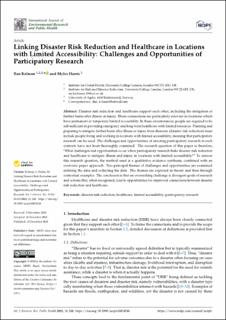Linking disaster risk reduction and healthcare in locations with limited accessibility: Challenges and opportunities of participatory research
Peer reviewed, Journal article
Published version

View/
Date
2020Metadata
Show full item recordCollections
Original version
Kelman, I. & Harris, M. (2021). Linking disaster risk reduction and healthcare in locations with limited accessibility: Challenges and opportunities of participatory research. International Journal of Environmental Research and Public Health (IJERPH), 18 (1). https://doi.org/10.3390/ijerph18010248Abstract
Disaster risk reduction and healthcare support each other, including the mitigation of
further harm after illness or injury. These connections are particularly relevant in locations which
have permanent or temporary limited accessibility. In these circumstances, people are required to be
self-sufficient in providing emergency and long-term healthcare with limited resources. Planning and
preparing to mitigate further harm after illness or injury from disasters (disaster risk reduction) must
include people living and working in locations with limited accessibility, meaning that participatory
research can be used. The challenges and opportunities of enacting participatory research in such
contexts have not been thoroughly examined. The research question of this paper is therefore,
“What challenges and opportunities occur when participatory research links disaster risk reduction
and healthcare to mitigate illness and injury in locations with limited accessibility?” To answer
this research question, the method used is a qualitative evidence synthesis, combined with an
overview paper approach. Two principal themes of challenges and opportunities are examined:
defining the data and collecting the data. The themes are explored in theory and then through
contextual examples. The conclusion is that an overarching challenge is divergent goals of research
and actions that, when recognized, lead to opportunities for improved connections between disaster
risk reduction and healthcare.
